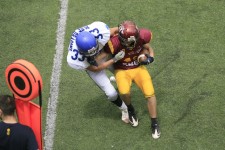The current concussion epidemic in football and other contact sports has spurred a national debate on how to minimize the risk of head injuries, particularly in youth sports. Even President Barack Obama has been quoted saying that if he had a son, "I would not let my son play pro football," because of the risks of head injury.
Professional football is one thing, those are grown men, well trained, and they know the risks. What about kids? That was the subject of a recent New York Times op-ed by Dr. Bennet Omalu, the physician who tirelessly fought to show the link between football and concussions, and who will be portrayed by Will Smith in "Concussion," a new movie due out on Christmas Day.
In the movie, the National Football League comes off rather poorly, as it should, given their apparent attempts to silence Dr. Omalu, but league officials have done better recently. Their Heads up Football initiative teaches youth football coaches a variety of ways to reduce concussions among their players and gets credit for making the youth game safer.
But can it ever be safe enough? That is the issue for Dr. Omalu, who believes there is no safe way to play football, or other high-impact contact sports, and so it should only be a choice when kids are legally able to make their own choices, at the age of 18.
He makes that case that we often use this approach. Alcohol and smoking are two activities in which kids cannot legally participate, and in most indoor public places people can't smoke because of the risks to others. In his op-ed, Dr. Omalu wonders why this line of action has not followed for contact sports. He references two prominent groups, the American Academy of Pediatrics and the Canadian Pediatric Society, which have indicated that children should not be allowed to play youth sports characterized by a significant degree of violence.
Is smoking equivalent to football? The American Council on Science and Health has fought to show the dangers of smoking for 37 years, and we have also shown that kids should engage in exercise, free play, sports and have much less "helicopter parenting" for many reasons.
"Our children are minors who have not reached the age of consent. It is our moral duty as a society to protect the most vulnerable of us," Dr. Omalu wrote. "The human brain becomes fully developed at about 18 to 25 years old. We should at least wait for our children to grow up, be provided with the information and education on the risk of play, and let them make their own decisions."
Using smoking as analogous to football is false equivalence. Injuries are a reality in all youth sports and activities, and at a time when the childhood obesity epidemic is a major public health issue, it seems counterproductive to worry parents or ban kids from engaging in physical activity.
When it comes to youth sports, concussions are not the big problem. Sprains and strains, fractures and contusions are all more frequent in youth sports than concussions. Of the 1.35 million emergency-room visits tied to youth sports, only about 12 percent were concussion related.
This is the brain we are talking about. Presumably, everyone wants to protect children from concussions, but there is a concussion risk in all youth sports, even in low-to-no-contact sports.
According to a study in the American Journal of Sports Medicine, 64 concussions occur for every 100,000 games or practices in high school football; for boys ice hockey that number is 54. But girls soccer is not that far behind on the list, with 34 concussions per 100,000 games or practices. Boys wrestling (22) a high contact sport, and girls basketball (21) a low contact sport, have similar rates. The concussion rate in high school cheerleading, which is not a contact sport at all, is 14 per 100,000 games or practices.
If the worry is any risk of concussions, we have to ban all sports.
Instead of legally barring kids from participating until age 18, parents need to make responsible, informed decisions for their children that balances all factors using a risk-benefit scale. Toward that end, the Council is about to release a peer-reviewed publication on concussions in youth sports which will inform parents, coaches, and leaders on the real science of the concussions epidemic.



